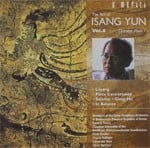1.1.1.1-0.0.0.0-perc(4):tgl/wood cym/whip/SD/BD/plate bells/tam-t/vib-harp-vln.vlc
Abbreviations (PDF)
Bote & Bock
Yun's success with Loyang, a work in three movements for chamber ensemble (woodwinds, numerous percussion instruments, harp, violin and violoncello) composed in 1962, affirmed him on his way towards Réak, his first main work. (Réak also marked his international breakthrough as an avantgarde composer in 1966.) After many efforts to have Loyang premiered, Yun succeeded in arousing conductor Klaus Bermbacher's interest for the piece which was first played during the New Music Days on January 23, 1964, in Hannover, by the studio orchestra of the Jeunesses Musicales.
Loyang was several times the eastern capital of the old China – last in the 10th century. The town was thus the centre of Chinese court music which was exported to Korea as tang-ak (music of the T'ang era, 618–906). There, it was restored as a-ak (elegant, refined music) in the 15th century. Chinese and Korean court music have been passed on until our days under the collective notion of chông-ak (aristocratic music).
Isang Yun's Loyang conserves, mostly in the 3d movement, the memory of Korean tang-ak. The title reminds of the suite for orchestra Nagyung ch'un (Spring in Loyang, in Chinese: Loyang ch'un). The text has been preserved, but not the music. Instead an adaptation of this aristocratic arts' music is played in Korea even nowadays. The 1st movement of the suite Yôngsan hoesang, called Sang-yôngsan, may be considered as the base of a very free adaptation by Isang Yun, as the musicologist H. Oesch has shown. The text deals with Buddha teaching on the vulture mountain Yongch'wi. The music, meant to accompany song and court dance, is performed as a purely instrumental music of leisure since the 19th century. – The instrumentation of Yun's Loyang, however, is rather similar to the orchestra piece Sujech’ôn based on the song Ch’ôngûp ("Rise, o Moon!"). This song tells of the worries about the lover coming home in the dark.
Yun's Loyang does, on one hand, rest on a 12-tone-series of the interval classes -2, +3, +3, -2, +1, -6,-2, -5, -1, -3, -1, but on the other, its structure doesn't strictly follow the 12-tonesystem (in the sense of the Schönberg school). While in the rather calm 1st movement and the animated 2d movement, Yun still seems to search for this consequently heterophonic sound technique which becomes so characteristic between Réak (1966) and Dimensionen (1971), it gathers clear shape for the first time in the mostly calm 3rd movement. After the first performances, Yun shortened Loyang in 1964; the second version has to be played nowadays.
The 1st movement presents an introductory part in an arched line – a musical anticipation of the 3rd movement – four main segments and an epilogue. The work begins with a primary sound impulse on the harp string struck with a nail. Strings, vibraphone and wood winds awake with long held chords. The introductory sound proceeding is ended by impulses of the percussion section and brisk chords of harp and strings. In the main segments, loosely joined melodic ideas in wide, upward bound intervals of the flute are dominant. They are interrelated like variations. The opening sound proceedings all pass by turning points marked by percussion and run into a kind of cadenza conclusion. On the whole, woodwinds, harp and strings play a rather supporting role; the melodic idea of the flute, however, is picked up by the violin, later by the cello. The oboe opens the Abgesang of the 3rd segment. Finally, the epilogue appears as a second conclusion with the "theme" played by the flute.
The 2d movement, divided into four parts, is shaped by the principle of instability. The opposed treatment of strings and windplayers shows first traces of Yun's conception of sound families which later became important for him. The concertante elements seem to anticipate Yun's concert period which he started in 1975/76 with the Cello Concerto. The oboe's solo introducing the 1st part is a succession (but not yet a chain) of held tones, pounced upon from wide-span-appoggiature. At once, the other woodplayers wind about it in a more contrapuntal than heterophonic manner. The strings remain silent and only start to move when the woodwinds yield. In the 2d part, also opened by the oboe, the woodplayers dominate. Even the turning point with its brisk, hollow string chords, doesn't lead to a balance. The 3rd and 4th parts are opened by the strings in an almost dancing manner. In the 3rd part, strings and woodplayers meet temporarily. Bassoon, oboe and clarinet – mediated by figurations of the latter – now display an upward-bound concept in free imitation. Thus going back to the 1st movement, the balance shifts in favour of the strings. In the 4th part, strings and woodplayers confront each other antagonistically; in the final phase, the flute's musical discourse remains on its own, as if it were a monologue.
Hollow pizzicati of the strings open the 3rd movement. In the oboe's solo, supported by the heterophonic multiplication of the main tone to the main chord played by clarinet and bassoon, a genuinely East-Asian melody type, characterized by minute intervals, appears and is also taken up by the strings. While the 1st part still runs in two phases, the 2d and 3rd parts both develop a sound stream with an interior fluctuating motion. They are built up following the principles of densification and pitch extension. A fragile epilogue, with a thinnedout sound, concludes the composition.
Walter-Wolfgang Sparrer (1987, translation: Frank Heibert)

Members of the State Symphony Orchestra of Demcratic People's Republic of Korea / Francis Travis
Camerata CMCD-50029
